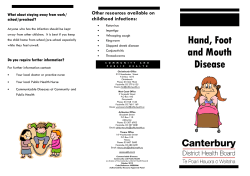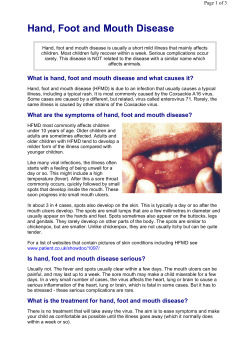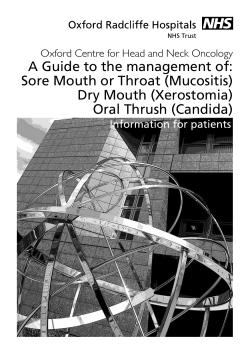
Hand, Foot, and Mouth Disease
Hand, Foot, and Mouth Disease [Announcer] This program is presented by the Centers for Disease Control and Prevention. If you take care of children, you need the facts about hand, foot, and mouth disease. Hi, I'm Dr. Eileen Schneider, a medical epidemiologist at the CDC. Hand, foot, and mouth disease is a contagious illness caused by viruses. It mainly affects children younger than five, but older children and adults can get it, too. Hand, foot, and mouth disease is sometimes confused with foot and mouth disease, but the two have nothing to do with each other. Foot and mouth disease only affects animals. In this podcast, you’ll learn about the symptoms of hand, foot, and mouth disease, how it spreads, and ways to help protect yourself and your children from getting infected. If you get hand, foot, and mouth disease, you may experience fever, reduced appetite, sore throat, and a vague feeling of being unwell. A day or two later, you may get painful sores in your mouth. You may also develop a non-itchy skin rash on the palms of your hands and soles of your feet. This rash can also occur on your knees, elbows, and some other parts of your body. The rash appears as flat, red dots that may turn into bumps or blisters. In the United States, people usually get the disease in the spring, summer, and fall. Hand, foot, and mouth disease usually causes mild illness, and most people completely recover in seven to 10 days. But children can experience a significant amount of discomfort. Painful mouth sores may make it hard to swallow, which can lead to dehydration. If your child is having trouble drinking fluids, or if you’re concerned about symptoms, call your health care provider immediately. If you get infected with the viruses that cause hand, foot, and mouth disease, you may not get all the symptoms. You may get only mouth sores or skin rash. And some people, including most adults, have no symptoms at all. Even so, they can still pass the virus to others. The viruses that cause hand, foot, and mouth disease spread easily when an infected person coughs or sneezes and the droplets are inhaled by the people around them. You can also get infected by touching a surface that has viruses on it, such as a toy or doorknob, and then touching your eyes, nose, or mouth. The viruses can also spread through blister fluid or stool from an infected person. This often occurs when changing a diaper or potty-training. People with hand, foot, and mouth disease are most contagious during the first week their symptoms appear. To help protect others from being infected, you should stay at home while you’re sick with hand, foot, and mouth disease. Keep children home until their fever goes away and their sores have healed. This will help reduce the spread of illness, but it won’t eliminate it completely. The virus that causes hand, foot, and mouth disease can live in a person’s body for weeks, even after symptoms disappear. If you’re not sure when to return to work or send your children back to school, ask your health care provider. Hand, Foot, and Mouth Disease Page 1 of 2 July 2013 If you do get hand, foot, and mouth disease, there’s no treatment. Hand, foot, and mouth disease is caused by a virus and antibiotics do not work against viruses. You can help relieve symptoms by using a mouthwash or spray that numbs mouth pain. Over-the-counter medications can help reduce pain and fever, but children should never take aspirin. There is no vaccine for hand, foot, and mouth disease, but there are things you can do to help protect yourself and your children from getting it. Wash your hands often with soap and water, especially after changing diapers and using the bathroom; Avoid touching your eyes, nose, and mouth with unwashed hands; Avoid close contact with an infected person, including kissing, hugging, and sharing cups and eating utensils; And disinfect frequently touched surfaces, such as toys and doorknobs. To learn more about hand, foot, and mouth disease, visit cdc.gov and select “Hand, Foot, and Mouth Disease” from the A to Z list. [Announcer] For the most accurate health information, visit www.cdc.gov or call 1-800-CDC-INFO. Hand, Foot, and Mouth Disease Page 2 of 2 July 2013
© Copyright 2025





















